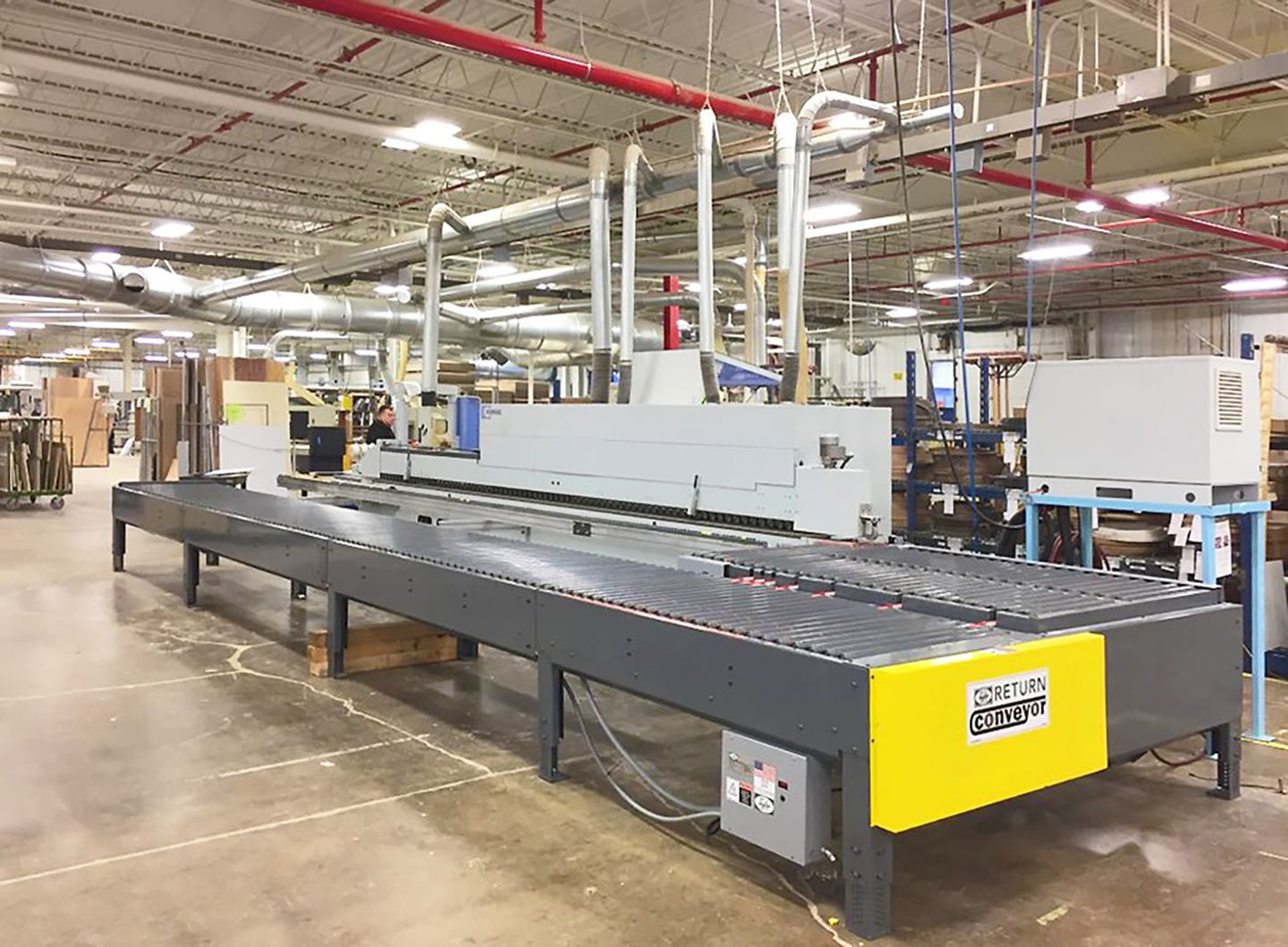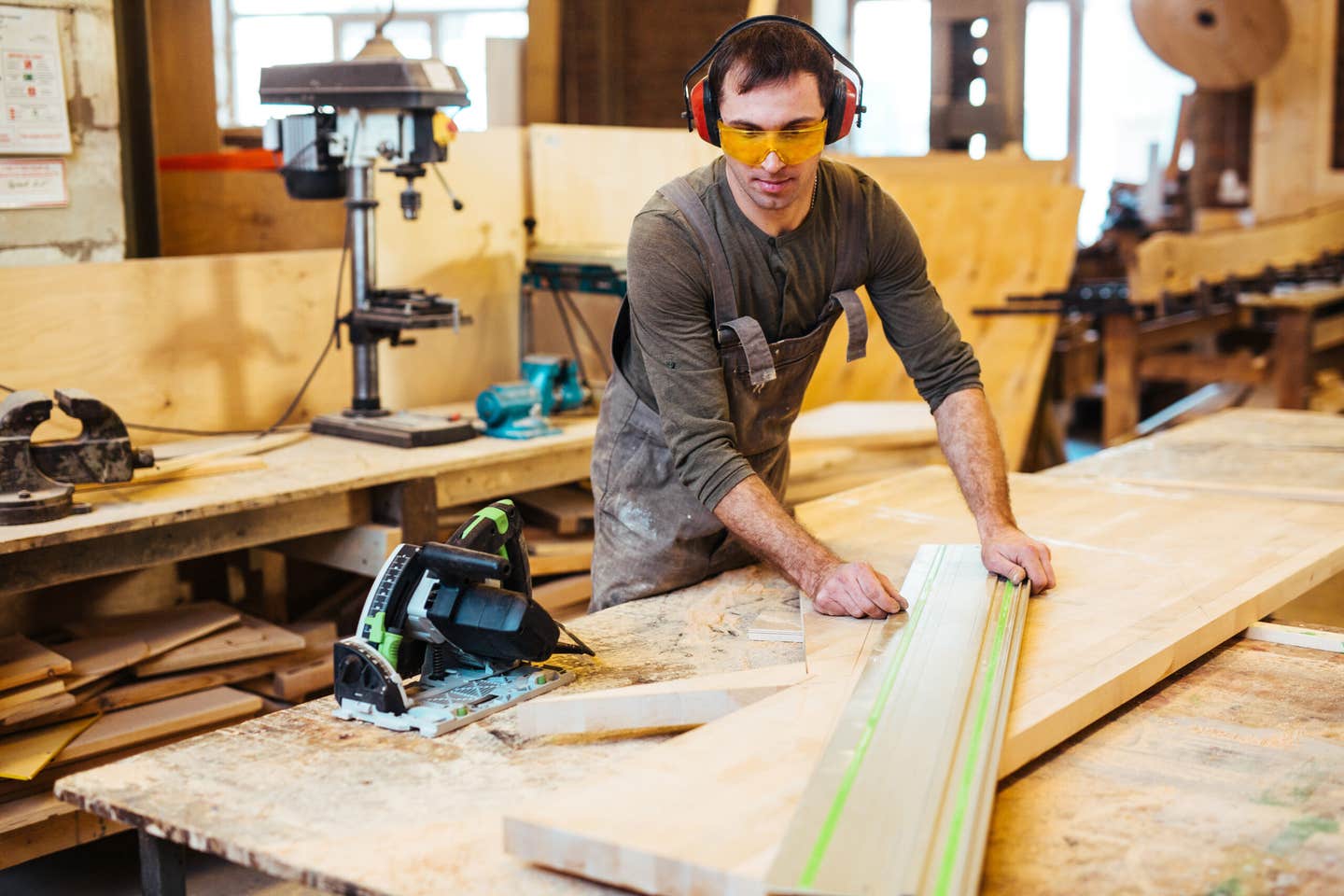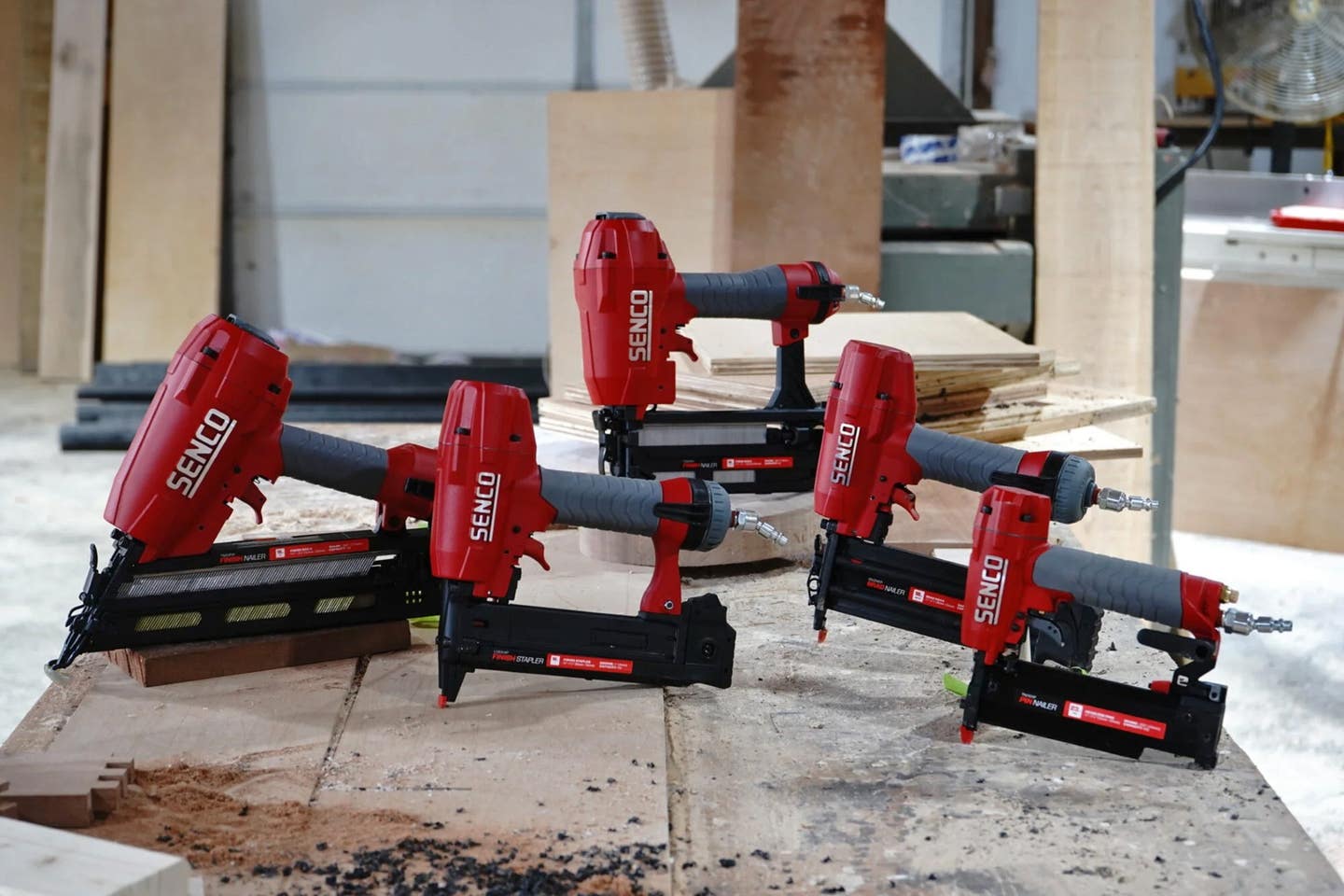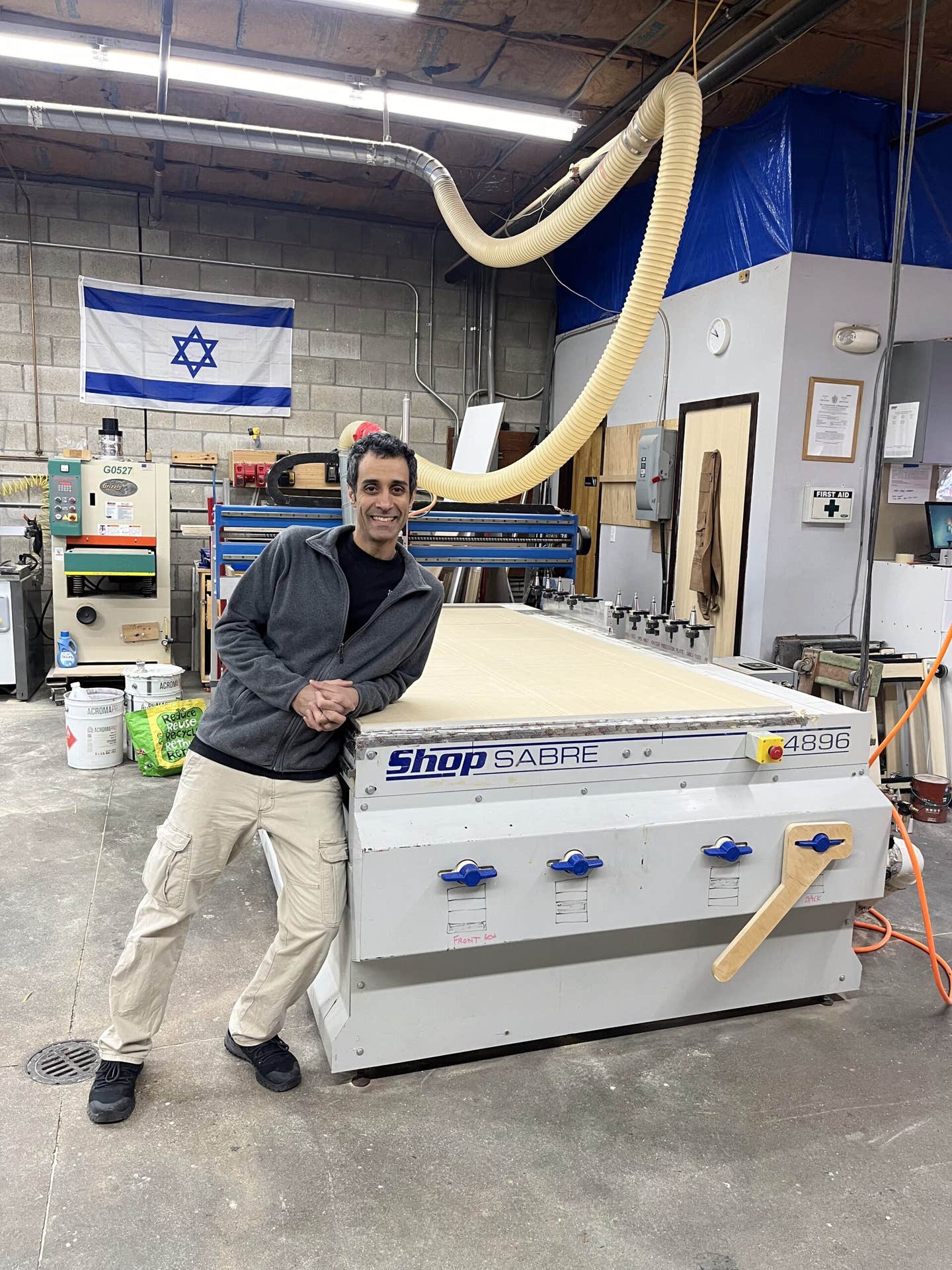Packing a punch
New nail, brad and staple guns have features we’ve come to rely on
What kind of nails do woodworkers hate to hit?
Fingernails!
We know that’s a sad old joke because it has been a long time since most cabinet or furniture builders drove finish nails or pins with a hammer. Nail guns are a whole lot faster and more accurate, and unlike hammers it’s not easy to bend a pneumatically driven pin when it’s halfway home.
Choosing the right nail gun can be a challenge, given the large number of manufacturers and the various types, sizes and angles. Plus, there’s a lot happening in the world of nail, pin, and staple guns. New choices begin with the power source. A gun can be driven by compressed air and hoses, or by a battery pack, an electric cord, or a gas cylinder. There are also several types of guns, and sometimes their functions overlap.
Types of guns
The largest gun, a framing nailer, is used to drive long nails with heads on them. It’s most useful in rough carpentry rather than in cabinet or furniture shops. There are also some specialized large nailers such as roofing guns that are used to install shingles, and dedicated flooring guns. There are even guns made to drive fasteners into concrete, such as the Aerosmith cordless gas pinner. But for the most part, woodshops use finish nailers, and many users prefer sealed guns rather than ones that need oiling, so they don’t contaminate finishes. Finish guns drive nails with small heads for installing moldings and trim, assembling larger furniture parts, and sometimes even hanging cabinets. There’s a small finish nailer called a palm nailer that can reach into very tight spots, and these only hold one nail at a time. And for anything smaller than the size of a 4d finish nail, there are pin and brad nailers.
These can be confusing. Brads have a very small head and pins have none, and there are some other significant differences, too. Brads are 18-gauge (and sometimes larger) nails that can be up to 2” long, while pins are generally a smaller 23-gauge in diameter and most often just an inch or less in length. In fine work, brads usually require that the recess is filled and sanded, while pin holes are so small that they are often ignored or just sanded, stained and clear-coated. Both brads and pins are used to keep very small moldings, stops/retainers, and trim in place, and they are also very helpful in keeping parts aligned while glue dries.
While both brads and pins are quite resistant to shear (sideways force), the biggest difference here is that the heads on brads also offer some vertical hold. So, brads are used for more permanent fixing, while pins are used when boards are going to be pulled apart eventually. Neither of these small gauge fasteners will split wood easily, where a finish nailer might. And the pin nailer will probably not even split veneer. Woodshops that rarely work with very thin parts (such as maybe glass retainers in a small jewelry box, or miniature mitered photo frames) will get a lot more use out of a brad nailer than a pin nailer.
There’s one more option for woodworkers who want to use inter-fibrous friction fasteners (okay, nails). There’s the two-legged nail, also known as the narrow crown staple. As with brads, staples are used in many different situations including attaching moldings, trim and decorate turnings. The ‘crown’ is the little metal bridge that the two nails are attached to. Staples have a lot of holding power, and the narrower the crown is, the easier it is to hide. Staples are a perfect solution when they will be driven into a surface that is not an appearance face. For example, they are ideal for attaching leather, upholstery, or vinyl to the bottom of a chair seat. They can be used on a top surface if the staples are going to be covered by a molding. They’re a great way to assemble utility drawer boxes where butt joints are being used in plywood, and they’re popular with picture framers who drive them into the back of the frame to capture retainer strips. Staples are used to install underlay, and to attach thin plywood or hardboard backs to cabinets. Narrow crowns usually come with longer legs (tines), while wide staples are often shorter and shallower. Using a staple gun takes more patience than a nail gun, because if the operator fires too quickly the hammer will bounce, and then the staple won’t be set deep enough.
When it comes to gauge, a larger number means a narrower nail, just as it does with electric extension cords. Fine staples are in the 22 to 20-gauge range, mediums are 19 and 18, and heavy are from 16 to 10 gauge. A 10-gauge nail is about 2.6mm in diameter, which is about 1/10”.
The angle of a nail gun is designed to increase or decrease the magazine size (the number of nails it can hold), and it can also make a difference for access to various surfaces. Plus, some guns feel better for some users, so they will give up a few nails in the reservoir to get a more comfortable, all-day grip. Nails are collated (held together) with wire, plastic, or paper. The latter is biodegradable, but can cause problems in very warm, humid conditions.
Firing mechanisms
Guns have several modes or methods of firing. For rapid work, a contact or ‘bump’ mode lets the user simply bump the gun against the wood while the trigger is depressed, and the gun will then fire as rapidly as the operator can move it. What happens is that a sliding safety guide compresses when it meets the wood, and that allows a nail to be released and the anvil to drive it home. This is a mode that is most used by experienced carpenters when they are performing tasks such as nailing down sheeting. They are basically turning off the safety.
In single sequential mode, the operator keeps the safety guide compressed against the wood and moves the gun across the surface. The gun then fires every time the trigger is pulled. Bump mode is turned off. Single actuation is like single sequential, except that bump mode isn’t turned off for the first nail. You can bump fire one fastener and then the safety kicks on.
The ‘normal’ mode for most woodworkers in the shop is full sequential, where the operator needs to press the gun against the wood every time and then press the trigger. This is the safest way to operate, and it’s also the most intuitive because furniture and case builders usually need to place nails at very specific spots. That means they don’t move as quickly, so they don’t need to fire as fast as a rough carpenter.
Some of the newer features on nail, pin and staple guns have almost instantly become standard. For example, many tools now come with a directional exhaust, so that expelled air doesn’t blast into the operator’s face every time the trigger is pulled. The exhaust can also be pointed away from sawdust, so that it doesn’t create a cloud of fines for the woodworker to breathe.
Most guns now have a head that pops off or opens easily so that jams can be cleaned out quickly. A few years ago, it wasn’t uncommon to see a carpenter fiddling with a gun for several minutes trying to extricate a bent nail.
LED lights are built into many guns, and this is a feature to look for. It allows the woodworker to avoid small knots or splits that are not quite visible in ambient light.
Some guns can handle several different lengths or gauges of nails, so the shop may be able to get by with buying one type of gun instead of two.
For pneumatic guns, look for a swivel connection that avoids twisting the hose. Cheap plastic hoses can cause a lot of delays as airflow is easily restricted when they kink. A swivel connector can make it a lot easier to load strips of nails too, because the hose can be moved out of the way.
Tool-free depth adjustment is another of those new features that are becoming standard. Setting the nail head to the perfect depth shouldn’t require an Allen key or a wrench, especially when the gun is being used up a ladder or out on a jobsite and you forgot the tool.
Nailer news
Mixing up voltages in cordless tools is becoming the norm, and a new framing gun from Metabo/Hitachi (model NR3690DR) is a good example. It accepts any of the company’s MultiVolt batteries (named Multi because they run both 18- and 36-volt tools), and it also works on a 36-volt AC plug-in adapter. Selective actuation allows for quick changes between sequential and contact nailing with the flip of a switch. And Metabo’s new 36-volt, 21-degree duplex nail-gun (model NR3675DD) drives nails that have two heads and are used on the jobsite for tasks such as building knock-down concrete forms, and occasionally in the woodshop to fixture large parts on a CNC.
Senco has been very busy over the last year or so. The company’s new F-35FRHXP framer drives up to 3-1/2” full round head, plastic collated nails and is built with the company’s proprietary Fusion cordless pneumatic technology that uses an onboard air tank instead of a gas cylinder. There’s no ramp-up time between shots, allowing users to work quickly when bump firing. And Senco’s new F-35XP cordless framing gun also uses the Fusion platform that relies on a brushless motor to release a burst of compressed air that drives fasteners. It’s easy to switch between sequential and bump-fire modes and a woodworker can set the drive depth just by turning a knob. The gun has ‘smart’ indicator lights that show if a jam occurs, or when the battery is low.
Craftsman has released three new tools for its V20 battery system. They are a 16-gauge finish nailer (CMCN616C1), an 18-gauge brad nailer (CMCN618C1) and a 21° plastic collated framing nailer (CMCN621PLB) that handles nails from 2” to 3-1/4” long and has tool-free depth adjustment.
Makita U.S.A. has released a new 2‑1/2″ siding coil nailer (AN613) that drives 15-degree wire and plastic collated nails and is an upgrade on the popular AN611 model. The gun weighs only 5.1 lbs. and has a built-in air duster that clears dust, a multi-directional exhaust port that rotates 360 degrees, and tool-free depth adjustment. A selection switch offers either single sequential or contact modes. Makita’s clear loading canister with nail size adjustment allows the user to quickly view when it’s time to reload nails.
Smaller guns
Ridgid is offering a new 18-volt brad nailer through The Home Depot that takes 18-gauge fasteners from 5/8” to 2-1/8” long. The gun (item R09891B, listed at $199) is more compact and lighter in weight than its predecessor and has a small nose for better visibility. Ridgid says it drives flush at all angles with no blade slip. A selectable mode switch permits either contact actuation or single sequential actuation mode. There’s an LED light, tool-free depth adjustment, and a tool-free jam release mechanism.
A new 20-volt gun from Worx (the WX840L) shoots both brad nails and crown staples. It comes with a 2.0 Ah battery and a charger, and it fires up to 80 3/4” to 2” nails per minute, and up to 500 total shots on a single charge. The magazine holds 100 nails. It also delivers 3/4” to 1-1/2” narrow crown staples. There’s a quick-load magazine that makes it easy to reload, a contact actuated mode for quick firing and single sequential mode for precision work. It has tool-free depth adjustment, weighs just 6.3 lbs., and has dual LED lights.
Arrow (arrowfastener.com) makes a pneumatic brad nailer (PT18G) and pin nailer (PT23G) and offers the ET200BN electric brad nailer that has an adjustable depth control knob, a contact safety, a six-foot power cord, and a quick release magazine. It will run 5/8”, 3/4”, 1” and 1-1/4” long brads and is listed at $59 on various sites.
Bostitch (Bostitch.com) offers finish, brad and framing guns plus some specialty roofing and siding tools. The company’s line of innovative Smart Point nailers allow woodworkers to reach into tight spaces, improve accuracy and reduce work surface damage. They’re available in 18, 16 and 15-gauge versions and feature smaller noses. There’s no need to compress the contact trip to actuate the tool, which reduces both work surface damage and the risk of pushing the material out of position.
DeWalt’s catalog (dewalt.com) includes a new 21-degree plastic-collated framer and a 30-degree paper one, both of which operate on the 20-volt Max battery system. The company also has a full line of 20-volt finish and brad guns including straight 16 and angled 15-gauge finishers, plus 18-gauge narrow crown and brad staplers.
To get some idea of the extensive Grex catalog, it includes brad nailers, 23-gauge headless pinners, and 21, 18, 16 and 15-gauge nail guns. There’s an angled 15-gauge finish nailer (the AF64) that drives brads from 1” to 2-1/2” long, and its adjustable depth-of-drive feature allows fasteners to be flush with the surface, or countersunk. It has a contact safety with no-mar tip, a 360-degree adjustable exhaust, a depth-of-drive adjustment, a durable aluminum magazine and rear loading for fast continuous reloads.
Grizzly (grizzly.com) offers five brand name guns – the 18-gauge H776 brad/stapler, the H7665 21-degree framer, the H5527 which is an 18-gauge nailer for 5/8” to 2” long brads, the H8231 15-degree coil nailer (it shoots roofing and standard nails from 1-3/4” to 2-3/4” long and features a 225-300 nail capacity), and the H6143 finish gun that uses 1-1/4” to 2-1/2” nails. Prices range from $59.25 to $185.95.
Max USA Corp. (maxusacorp.com) makes roofing, brad, finish, and framing guns. The catalog is wide-reaching, and the brand is a popular one with professionals. Among the newest guns are the HN65S high pressure siding and decking coil nailer and the NF255SF2/18 brad nailer. The latter is extremely light and has a built-in duster button to clear debris when placing a shot, a precision point contact nose for extremely accurate placement, a tangle-free swivel hose connector, and a see-through magazine.
Milwaukee (milwaukeetool.com) also has a comprehensive catalog of cordless nailers and staplers including nine 18-volt and three 12-volt tools. There are also a couple of pneumatic guns – a 3-1/2” full round head nailer (7200-20) and the 7220-20 roofing nailer that unfortunately doesn’t get good reviews on the company’s website. The cordless guns use the M Fuel battery system and are well received and reviewed by users. The 2447-20 is a 12-volt stapler designed to drive a range of 3/8” flat crown staples (1/4” – 9/16”), and it weighs just 3 lbs. At just 7-1/4” long, the compact design allows for great access into tight spaces and convenient tool belt portability. It has sequential and contact actuation.
Paslode has framing, finish and siding/roofing guns that variously come with or without pneumatic hoses. The company was an innovator in the gas cylinder cordless market, and still feels that a fuel/battery combination is the best jobsite solution (they’ve just released the new Cordless XP framing nailer). I’ve used the gas guns at both sea level and at more than 6,000 feet altitude in the Rockies to frame and trim homes, and never had a problem. They’re surprisingly light, and the fuel is relatively easy to find. The new gun is just 7.2 lbs. and can drive 1,200 shots per fuel cell and 9,000 shots per full battery charge.
Porter-Cable (portercable.com) has just released a new 15-degree pneumatic coil roofing gun (the RN175C) that doesn’t have any reviews yet. Other recent releases were a 20-volt Max 16-gauge straight finish nailer (PCC792B) and a small impact palm nailer, the PN350, which has a front exhaust that directs air away from the user and a magnetic nose with a recessed nail slot holds one nail for accurate placement. It has a swivel connector to limit twisting of the air hose.
There’s a new 18-gauge brad nailer in Ryobi’s 18-volt ONE+ battery system (ryobitools.com). The P320 gun is very compact and lightweight and features the company’s AirStrike technology that draws air into the nailer and compresses it to power the driver head to sink the nail. It can drive up to 1,700 nails per charge using Ryobi’s new P108 4Ah battery. Also coming soon from this manufacturer is the P321, which is another 18-gauge brad nailer, and the P326 which is a 16-gauge finish nailer.
Woodshops can find less-familiar gun brands online, many of which have attractive price tags and great reviews. Listed alphabetically, some brands worth checking out include 3PLUS, Air Locker, B&C Eagle, BHTOP, Carpenter Air Tools, Fafeicy, Fasco, Freeman, FTVOGUE, Hilitand, Hotop, Meite, NuMax, WEN and WorkPro, to name a few.
We began with an awful joke, so let’s close on one, too. Did you hear about the upholsterer who got injured when he lost control of his staple gun? He’s fully recovered.
This article was originally published in the October 2021 issue.







